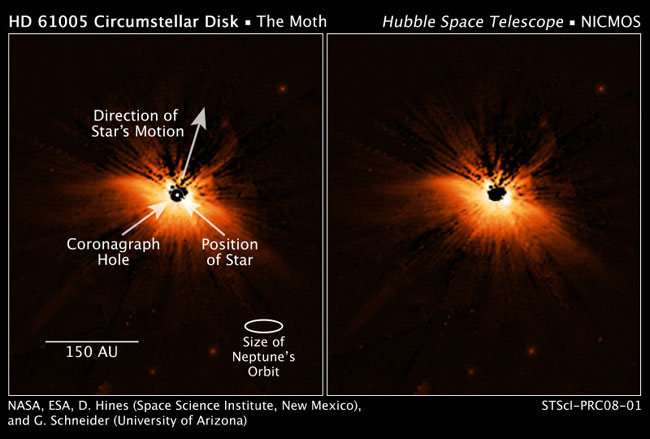Big Space Thing Looks Like a Moth

A moth-likestructure with a 22-billion-mile wingspan is hovering out in space.
This giantis actually a massive cloud of dust surrounding a nearby, young star imaged bythe Hubble Space Telescope that has shown astronomers that these dustdisks can take on unexpectedly unusual shapes.
Such disks aretypically flat, pancake-shaped structures where planetscan form. But HD 61005's disk breaks from the norm with a shape dubbed"The Moth". The shape is produced by starlight scattering off thedust.
"It iscompletely unexpected to find a dust disk with this unusual shape," saidsenior research scientist Dean Hines of the Space Science Institute in Corrales, New Mexico. "We think HD 61005 is plowing through a local patch ofhigher-density gas in the interstellar medium, causing material within HD61005's disk to be swept behind the star."
Hines saidthat such a collision was unexpected "because the area through which ourSun is moving was evacuated within the past few million years by at least onesupernova? Yet, here's evidence of dense material that's very close, only 100light-years away."
The Moth ispart of a survey of sun-like stars that Hines and his colleagues haveundertaken with Hubble and NASA's SpitzerSpace Telescope to study the formation and evolution of planetary systems.
Astronomershave found evidence that the environment a star forms in can influence theprospects for planet formation around it. But Hines and his team are uncertainhow passage through a cloud similar to the one HD 61005 is in would affectplanet formation.
Breaking space news, the latest updates on rocket launches, skywatching events and more!
"Whateffect this might have on the disk, and any planets forming within it, isunknown," Hines said.
Hines andhis colleagues presented their finding today at a meeting of the AmericanAstronomical Society in Austin, Texas.
- Video: When Stars Collide
- Vote: The Best of the Hubble Space Telescope
- Images: Hubble Space Telescope's Greatest Hits

Space.com is the premier source of space exploration, innovation and astronomy news, chronicling (and celebrating) humanity's ongoing expansion across the final frontier. Originally founded in 1999, Space.com is, and always has been, the passion of writers and editors who are space fans and also trained journalists. Our current news team consists of Editor-in-Chief Tariq Malik; Editor Hanneke Weitering, Senior Space Writer Mike Wall; Senior Writer Meghan Bartels; Senior Writer Chelsea Gohd, Senior Writer Tereza Pultarova and Staff Writer Alexander Cox, focusing on e-commerce. Senior Producer Steve Spaleta oversees our space videos, with Diana Whitcroft as our Social Media Editor.
